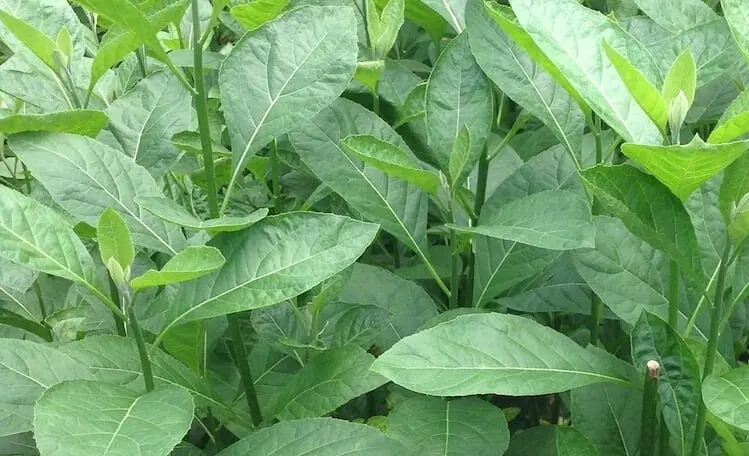Bitter leaf plants are shrubs and their leaves are used as a vegetable. Vernonia amygdalina, Vernonia colorata, and Vernonia calvoana are the three species usually grown.
Ecology of the plant
Vernonia grows in all types of soils. It is fairly drought resistant except for the species V. calvoana, which is more sensitive. Vernonia plants thrive in full sunlight.
Botany of Bitter Leaf
The habit of the shrub depends very largely on how the plant is exploited. For instance, a dense bushy habit is obtained if the stems are pruned severely regularly to stimulate leaf production.
The plant will develop a tall habit if the stems are allowed to grow unchecked for pole production.
The plants can grow up to 5cm or more in height.
The leaves are simple and are up to 15cm wide and 30cm long. The leaves of Vernonia calvoana are larger, more tender, and less bitter than those of Vernonia amygdalina (bitter leaf).
The inflorescence is composed of color fragrant flowers.
The seeds are surmounted by a pappus.
Bitter leaf has a dense root system. Most of the roots arise from the base of the plant and spread in the top 20 to 30cm of the soil. Only a few roots are deeply penetrating.
Cultural Practices
Propagation is by seed or by cuttings from mature stems although Vernonia calvoana is more difficult to propagate from cuttings. The seeds survive well in storage.
Vernonia is cultivated in gardens, farms, and orchards. It can be sown in mixtures with other crops.
The seeds are broadcast in nursery beds. The plants are pruned when they have 4-6 leaves and are then transplanted (with a ball of soil or with exposed roots).
Cuttings are planted erect or in a slanting position at 75 x 50cm. Topping or stooling the plants every year and removing suckers stimulates leaf production and ensures the production of larger, more abundant foliage.
Harvesting of Bitter leaf
The leaves can be harvested in three ways:
- By cutting leafy shoots.
- By gathering the leaves with the petioles, or
- By gathering the leaf blades only.
The best results are obtained by cutting the leafy shoots in the rainy season because the harvested shoots are quickly replaced.
However, in the dry season, picking the whole leaves without cutting the shoots is said to be more productive.
Storing of the leaves
Vernonia leaves are washed and then dried for storage but the taste is altered but this practice. The dried leaves should be steeped in water before they can be used.
Uses of Bitter Leaves
1. The leaves are used for making soups. The leaves and young shoots are cooked as vegetables.
They are rich in protein and vitamins. The bitter flavor of these plants has to be reduced by repeated culinary treatments such as scalding and squeezing with the result that the not-so-bitter varieties and species are very popular.
This is why Vernonia calvoana has an advantage over other species because its leaves are larger, more tender, and sweeter.
Diseases and pests of Bitter leaves
The diseases that affect the plant are mostly foliar. Leaf eating insects consume large leaf areas of the plant but it recovers easily due to the compensatory effects of many leaves that are produced.
Zonocerus spp. and mole crickets are some common insects that consume the leaves.








